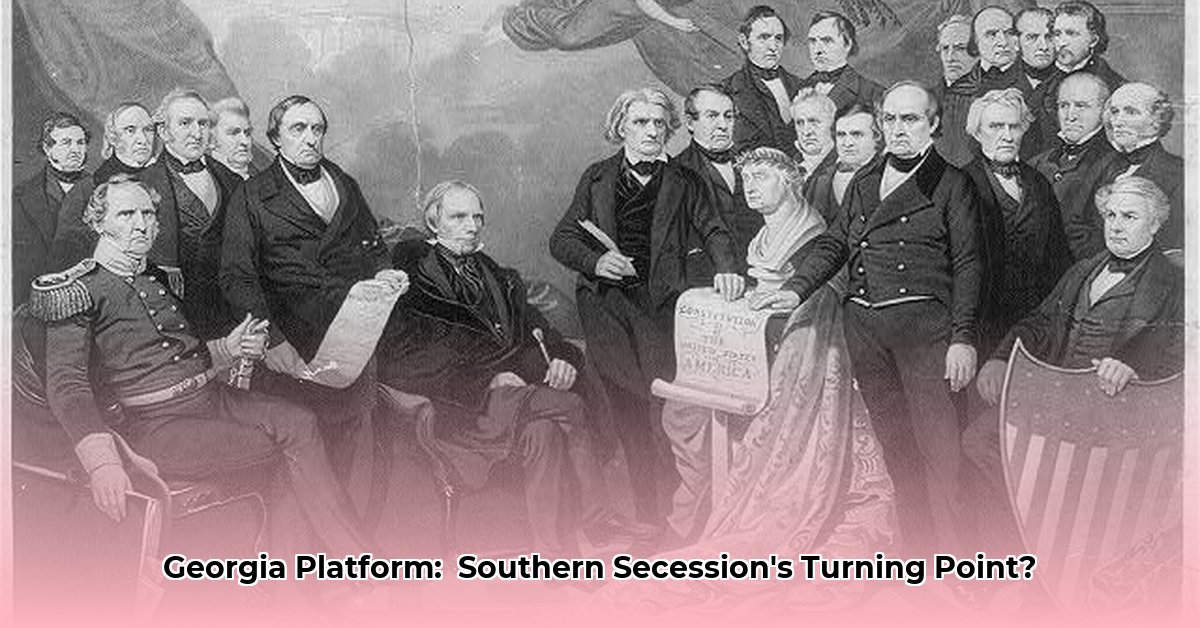The Compromise of 1850, crafted to address the escalating tensions between North and South over slavery, produced a fragile truce. In Georgia, this compromise ignited a firestorm of debate, culminating in the creation of the Georgia Platform. This intricate political strategy represented a high-stakes gamble with the fate of the Union. Was it a sincere effort to maintain peace, or a calculated maneuver masking a path towards secession? This article delves into the complexities of the Georgia Platform, exploring its origins, its impact, and its legacy in the tumultuous decade preceding the Civil War.
Navigating a Divided Landscape: The Genesis of the Georgia Platform
Georgia’s political landscape in 1850 was fraught with tension. Influential figures like Alexander Stephens, Robert Toombs, and Howell Cobb found themselves in a precarious position, caught between the rising tide of secessionist fervor and the dangers of outright defiance of the federal government. The Georgia Platform emerged from this political crucible, a meticulously crafted document that outwardly embraced the Compromise of 1850 while subtly laying the groundwork for a potential separation from the Union. This strategy aimed to appease both Unionists and secessionists within Georgia, a formidable balancing act in a deeply divided state. The platform’s architects sought to navigate the treacherous currents of sectionalism, but their efforts ultimately proved insufficient to prevent the looming national crisis. The document reflected the deep anxieties and conflicting loyalties that characterized the antebellum South.
Deciphering the Platform: A Study in Calculated Ambiguity
The Georgia Platform did not outright reject the Compromise of 1850. Instead, it strategically declared the compromise a “final settlement,” while simultaneously outlining a series of conditions that, if violated, could trigger secession. Any Northern action perceived as encroaching upon Southern rights, such as interference with the interstate slave trade, weakening the Fugitive Slave Act, or obstructing the admission of new slave states, would be deemed unacceptable. This calculated ambiguity was designed to provide a semblance of unity while leaving room for future action should the political climate shift. The platform’s carefully chosen words allowed for multiple interpretations, a testament to the political maneuvering and strategic calculations of its creators. The document’s inherent ambiguity reflected the deep divisions within Georgia and the precarious nature of the peace it sought to establish.
The Platform’s Resonance and Lasting Consequences
The Georgia Platform’s influence resonated beyond Georgia’s borders, finding favor in other Southern states grappling with the implications of the Compromise of 1850. Alabama and Mississippi, sharing similar concerns about the balance of power between North and South, adopted comparable platforms. This widespread adoption highlighted the depth of Southern anxieties about the future of slavery and the perceived threat to their economic and political autonomy. While the Georgia Platform temporarily forestalled secession, its long-term impact remains a subject of historical debate. Did it merely postpone the inevitable conflict, or did its ambiguous language exacerbate existing tensions, ultimately contributing to the outbreak of the Civil War? The platform’s legacy is complex and multifaceted, reflecting the intricate political dynamics of the antebellum South. It serves as a critical case study in the escalating tensions that ultimately led to the nation’s most devastating conflict.
Political Fragmentation and the Road to Disunion: The Platform’s Legacy
The Georgia Platform’s inherent ambiguity contributed to the growing political fragmentation within the state and the broader South. This ambiguity became a source of both unity and division, shaping the political discourse in the years leading up to the Civil War. The platform’s attempt to balance compromise with the assertion of Southern rights proved increasingly untenable as sectional tensions escalated. The lack of precise language regarding the acceptable limits of Northern action created a breeding ground for mistrust and misunderstanding, fueling the fires of disunion.
The 1850s: A Decade of Political Upheaval and the Path to Secession
The 1850s witnessed a series of political realignments and escalating crises that ultimately led to the secession of Southern states and the outbreak of the Civil War. The Georgia Platform of 1850, with its inherent ambiguities, played a significant role in shaping this tumultuous decade. The platform’s attempt to reconcile conflicting interests within Georgia proved ultimately unsuccessful, reflecting the deep divisions that plagued the nation as a whole. Subsequent political platforms, including the Georgia Platform of 1861, reflected the state’s evolving stance on secession. The 1861 platform, in stark contrast to its 1850 predecessor, unequivocally embraced secession, marking a decisive turning point in Georgia’s history and solidifying the state’s commitment to the Confederacy. The two platforms serve as crucial markers in the trajectory towards disunion, illustrating the escalating tensions and the ultimately unsuccessful attempts to forge a lasting peace. They offer valuable insights into the complex political landscape of the antebellum South and the factors that ultimately led to the nation’s most devastating conflict.
- Unlocking 2-Letter Words with U: The Definitive Guide - April 4, 2025
- Unlock Words with the Letters THREE: Top Unscramble Tools 2025 - April 4, 2025
- Master Scrabble: X & Z Words for High Scores - April 4, 2025
















